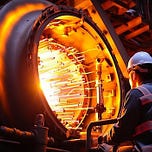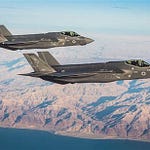
American Consumer, Come My Wayyy 🎵
Tariffs do raise prices, but the real-world impact is far less than the headlines - and far more complex than the politics.
The American consumer stands at ground zero in the latest “trade war”. With fresh tariffs imposed on goods from China, Europe, and elsewhere, panic-peddlers predict retail apocalypse. “A 50% tariff means your prices will skyrocket 50%!” they warn. It’s an alarming claim, theoretically sound on paper - and demonstrably wrong in reality.
This persistent misconception pervades policy discussions and media coverage, creating unfounded alarm. Tariffs do raise prices, but the real-world mechanisms of how tariffs translate to consumer costs remain consistently misunderstood and misrepresented.
The gap between tariff rates and retail price effects represents one of the most consequential economic disconnects in public discourse. Understanding this relationship isn’t just academic - it affects national security policy decisions, business planning, and consumer behavior during periods of trade tension.
Looking back at Trump’s first-term tariffs provides empirical evidence to separate economic reality from overheated rhetoric. By analyzing the actual price impacts from the 2018-2019 trade actions, particularly on steel and aluminum, we can build a more accurate model of what to expect this time around.
How Tariffs Actually Work 📊
Tariffs apply to the transaction value – the price importers pay to exporters plus shipping and insurance – not the final retail price. By the time a product reaches consumers, it has been marked up to cover domestic logistics, warehousing, labor, utilities, profit margins, and more. This fundamental distinction means a 50% tariff translates to a much smaller retail price increase.
Historical data from the 2018-2019 tariffs demonstrates this clearly. The National Bureau of Economic Research found that a 10% tariff typically resulted in a 1-2% retail price increase – not 10%. More recent research from the Federal Reserve Bank of Atlanta suggests rates of 0.8% to 1.6% for a 10% tariff, depending on pass-through assumptions.
Perhaps most significantly, the highly-studied 2018 steel tariffs show that while US steel prices initially spiked 53% higher than European prices following the 25% tariff, this premium moderated to just 7% within 18 months as supply chains adjusted, demonstrating the market’s ability to adapt over time.
Projected vs. Actual Tariff Impacts on Consumer Prices 📈
![[Table 1: Comparative Analysis of Projected vs. Actual Tariff Impacts (2018-2025) - Examining how theoretical price projections compare with historical evidence across product categories] [Table 1: Comparative Analysis of Projected vs. Actual Tariff Impacts (2018-2025) - Examining how theoretical price projections compare with historical evidence across product categories]](https://substackcdn.com/image/fetch/w_2400,c_limit,f_auto,q_auto:good,fl_progressive:steep/https%3A%2F%2Fsubstack-post-media.s3.amazonaws.com%2Fpublic%2Fimages%2Fbce241e5-8e73-4c14-a1f9-17a4272e1ed0_1478x2003.png)
Key Players and Perspectives 👥
Domestic Manufacturers: The Protected Class
American steel and aluminum producers were the primary beneficiaries of the 2018 tariffs, gaining pricing power in the domestic market. US Steel, Nucor, and Alcoa reported record profits in the quarters following implementation. The industry added approximately 4,800 jobs between March 2018 and March 2019.
Steel industry representatives have consistently advocated for continued protection, arguing that global overcapacity (particularly from China) threatens their viability. As noted by Leon Topalian, CEO of Nucor, these tariffs aim to “level the playing field” for domestic producers.
However, the jobs gained came at extraordinary cost. The Peterson Institute for International Economics calculated that steel companies earned approximately $270,000 in additional pre-tax profits for each job created, while steel users paid an extra $650,000 per job created.
Downstream Manufacturers: The Casualties
Companies that use steel and aluminum as inputs faced significantly higher costs. From auto parts to appliance manufacturers, construction firms to food processors, these industries employ far more Americans than the metal producers they rely upon.
A Federal Reserve Board study found that increased input costs from steel and aluminum tariffs led to approximately 75,000 fewer manufacturing jobs by mid-2019 than would have existed without the tariffs. This aligns with pre-tariff analysis showing steel-consuming jobs outnumber steel-producing jobs by 80 to 1.
“If the United States decides to raise its tariff basically just to match another country’s tariff, that country doesn’t just sit there idle,” explains Chad Bown, senior fellow at the Peterson Institute. “They will then raise their tariff even further.”
Consumers: The Ultimate Payers
While American consumers ultimately bear much of the tariff burden, the impact varies dramatically by product category. The 2018 washing machine tariff case study is particularly instructive: following tariffs, prices increased by approximately 12% (not the full 25% tariff rate).
Even more tellingly, dryer prices also increased by 12%, despite not being subject to tariffs – demonstrating how companies distribute costs across product lines and the complex ways tariffs ripple through the economy.
Mary Lovely of the Peterson Institute offers a useful comparison to understand trade relationships: “When I go to the grocery store, you know, I give them money. Are they ripping me off? No, I get groceries in return.” This simple analogy highlights the fundamental misconception in viewing trade deficits as losses and tariffs as solutions.
Small Business Perspective: Craft Brewers Face the Aluminum Challenge
For small businesses that rely on imported materials, tariff impacts can be devastating. Thor Cheston, co-founder of Right Proper Brewing in Washington, D.C., expressed serious concerns about the 25% aluminum tariffs: “It could be massive… Roughly, if we were to incur a 25% increase in that cost, it would be over $40,000 for us, which is the cost of an employee.”
Wesley Keegan, owner of Nashville-based TailGate Brewery, similarly highlighted the immediate impact: “Everything costs more. We get a price increase letter just immediately from every supplier.” Unable to easily pass costs to customers, craft brewers must absorb much of the expense themselves.
For many small breweries, raising prices isn’t a viable option. Joseph Cortes, executive director of Georgia’s Craft Brewer’s Guild, notes that “The last thing that our small breweries will do is raise prices on the consumer and pass that on” because beer is a discretionary purchase that consumers can easily cut from their budgets when prices rise.
The brewing industry’s challenges illustrate how tariffs on raw materials create ripple effects through the economy that far exceed their direct revenue impact.
Unknown Tariff Ripple Effects 🌊
The fundamental economic problem with tariffs on industrial inputs like steel and aluminum is their magnifying effect through supply chains. Each company that uses the tariffed material as an input faces higher costs, creating a cascade through the economy that multiplies the impact.
Historically, tariffs have been more successful when targeted at finished consumer goods rather than industrial inputs. The Smoot-Hawley Tariff Act of 1930, which significantly raised duties on over 20,000 imported goods during the Great Depression, is widely considered to have deepened and prolonged the economic crisis by triggering retaliatory measures from trading partners.
The contrast between President Trump’s first-term tariffs and current ones is revealing. The 2018 measures started at 25% for steel and 10% for aluminum but included numerous country exemptions and product exclusions. Current steel tariffs maintain the 25% rate but have eliminated exemptions and expanded to include derivative products.
This evolution reflects a fundamental tension in trade policy: the desire to protect domestic industry while minimizing harm to the broader economy. As Zanny Minton Beddoes, editor-in-chief of The Economist, recently observed, “This is, without a doubt, the biggest trade policy shock, I think, in history… This is off the charts in terms of scale, speed and uncertainty.”
Beyond Economics: The National Security Dimension
While price impacts dominate discussion of tariffs, national security considerations are increasingly central to trade policy. Recent disruptions in global supply chains have exposed vulnerabilities that could threaten national security, particularly in critical industries like semiconductors, pharmaceuticals, and advanced manufacturing.
Government policies are becoming more national security-focused while trying to maintain economic growth. This includes protecting key manufacturing capabilities as well as building supply chain resilience through an enhanced domestic industrial base. As countries become more inward-looking, competition over critical inputs increases, risking new conflicts and rivalries.
Brandon Daniels, CEO of Exiger, suggests that strategic tariffs could help build supply chain resilience if properly targeted: “Blanket tariffs on raw materials or components could backfire, raising costs for U.S. manufacturers and slowing progress in critical sectors. Targeting finished goods or strategically vulnerable areas, on the other hand, could actually drive more local production while maintaining supply chain integrity.”
The 2018 steel and aluminum tariffs were justified under Section 232 of the Trade Expansion Act, which authorizes tariffs on national security grounds. This framing assumes that a highly globalized economy can generate vulnerability for the domestic economy based on factors beyond simple trade balances, particularly the ability to acquire necessary materials from domestic sources during a national emergency.
These strategic considerations help explain why tariffs persist despite their economic costs – they’re increasingly seen as tools for managing geopolitical risk as much as economic policy.
Real Tariff Case Studies, Not Hype 🔍
The most comprehensive study on tariff pass-through rates comes from economists Alberto Cavallo, Gita Gopinath, Brent Neiman, and Jenny Tang, who studied retail prices for goods affected by the 2018-2019 tariffs. Their research, published in the American Economic Review, found that a 10 percentage point tariff increase typically raised retail prices by just 0.44 percentage points after one year.
Federal Reserve economists Aaron Flaaen and Justin Pierce documented the negative employment effects in manufacturing, finding that increased input costs from tariffs were associated with 0.6% fewer jobs in the manufacturing sector by mid-2019 than would have existed otherwise.
The highly publicized washing machine case study by Flaaen, Ali Hortaçsu, and Felix Tintelnot found that following 25% tariffs, washing machine prices rose approximately 12%, while dryer prices – not subject to tariffs – increased by the same amount. This demonstrated how companies distribute tariff costs across complementary product lines.
![Steel price index following 2018 tariffs]
US steel price index showing initial spike and subsequent moderation following 2018 tariffs. Source: Data compiled from Reuters, Gordian, and Federal Reserve analysis
That’s Not How It Works: It’s Not So Simple ❌
While the general pattern shows retail price increases significantly lower than tariff rates, the impact varies dramatically by product category and market structure. Electronics typically see higher pass-through rates than food products, for example.
Interestingly, tariffs often affect domestic producers’ pricing as well. With reduced foreign competition, American companies gain pricing power and frequently raise prices on their own goods. This “protection effect” means even products with zero imported content may see price increases following tariffs.
The time dimension complicates analysis further. Initial price spikes often moderate as supply chains adjust, new sourcing relationships develop, and companies implement cost-cutting measures. The steel tariff case exemplifies this: US prices initially rose 53% above European levels but moderated to just 7% higher within 18 months.
Questions remain about current tariffs’ long-term effects, particularly given their broader scope and elimination of many previous exemptions. The simultaneous application of tariffs across multiple trading partners and product categories creates unprecedented complexity in global supply chains.
Tariffs Affect Supply Chains, Not Prices Directly 📦
For American manufacturers like HCC in Mendota, Illinois, which produces harvesting equipment components, the steel tariffs created immediate challenges. “We’re the middle guy in the sandwich – squeezed from above and below,” explained CEO Brian Nelson. With steel as a major input cost, the company had to pass price increases to customers like Deere and AGCO, who then faced decisions about absorbing costs or raising prices on farmers.
Appliance manufacturers provide another clear example. Following washing machine tariffs, major producers like Whirlpool gained pricing power, but consumers paid approximately $1.5 billion more while the Treasury collected just $82 million in tariff revenue – a dramatic demonstration of tariffs’ economic inefficiency.
For everyday consumers, the impacts vary widely by purchase category. The Yale Budget Lab projects that under current tariffs, motor vehicle prices could rise 6.1% (approximately $2,900 on a $48,000 vehicle), while food prices might increase 1.7% overall, with fresh produce rising 2.9%.
Projection Wars: Tariff Data vs. Tariff Narratives 🔮
The disconnect between economic research and public messaging on tariffs reveals a striking contrast. Based on historical tariff pass-through data, empirical calculations suggest aggregate household impact of between 1,200 annually in the short term (first 6 months), potentially dropping to 800 as supply chains adjust.
This data-driven projection stands in stark contrast to many think tank estimates. The Tax Foundation projects an average cost of $1,300 per household, while the Yale Budget Lab suggests $3,800 in lost purchasing power – 1.5 to 4.5 times higher than historical evidence would indicate.
Why such dramatic differences? Think tanks frequently assume 80-100% pass-through of tariff costs to consumers, while empirical studies consistently show rates between 40-60% for most goods. Many projections also fail to account for supply chain adaptations that historically moderate initial price spikes over time.
Perhaps most significantly, political motivations may influence projections. As Mark Zandi, chief economist at Moody’s, recently warned, “I suspect by May — certainly by June, July — the inflation statistics will look pretty ugly.” This prediction, while concerning, still falls short of the catastrophic scenarios painted by some organizations with ideological positions that forecast Armageddon on trade policy.
What Actually Happens Next ⏱️
The immediate impact of current tariffs will not be fully felt until late May 2025, when goods currently in transit clear customs. According to US Customs and Border Protection guidelines, many products loaded before April 9, 2025, will face only the 10% baseline tariff rather than country-specific higher rates.
Medium-term adjustments will likely include accelerated “nearshoring” of production to countries with preferential trade agreements, particularly Mexico and Canada under USMCA, the United States-Mexico-Canada Agreement, which replaced NAFTA. Companies with flexible supply chains will shift sourcing patterns, while those with fixed infrastructure may absorb costs or exit certain markets.
Businesses are employing multiple strategies to adapt. Some are using Foreign Trade Zones (FTZs) to defer or reduce tariff payments, while others are exploring duty drawback programs that allow manufacturers to recover duties on materials used in exported products. Many are negotiating with suppliers or adjusting pricing carefully to maintain profitability without alienating customers.
Long-term, these tariffs could reshape global supply chains permanently if maintained for several years. Historical patterns suggest initial price spikes will moderate as markets adapt, though the elimination of exclusion processes in the current tariff regime may limit adjustment options.
Companies are already investing in supply chain resilience in anticipation of potential future US tariff hikes, including increased spending on visibility technology and greater reliance on third-party support. There’s growing interest in reshoring, particularly in anticipation of future tariffs, with substantial reshoring already observed in 38% of US product lines.
The critical variable remains political: whether these tariffs become negotiating leverage for bilateral agreements or a permanent feature of the trade landscape. The administration has signaled openness to country-by-country negotiations, suggesting the current structure may evolve significantly.
In essence, the immediate impact on consumer wallets, while real, is likely to be significantly muted compared to the headline tariff figures, particularly over the medium term as adaptations occur. This core finding counters the most extreme price predictions. Yet, the full picture revealed by past tariff events is one of complex and often costly adjustments throughout the economy. Increased profits and modest job gains in protected sectors coexist with higher input costs and statistically significant job losses in larger downstream industries. The fundamental challenge lies in balancing these documented economic impacts—both positive and negative—against the broader geopolitical and national security objectives driving the policy.
Behind the Reporting 🔎
This analysis draws on peer-reviewed economic research, government data, and statements from industry participants. Key sources include studies from the Federal Reserve, National Bureau of Economic Research, Peterson Institute for International Economics, academic economists, small business owners, and ordinary consumers.
Particular attention was given to empirical studies that measured actual price effects rather than theoretical models or projections. The focus on historical data from the 2018-2019 tariffs provides real-world evidence rather than speculative forecasts.
We sourced economic experts across the political spectrum to ensure balanced perspective, including researchers who have both supported and criticized tariff policies. All numerical claims derive from published economic research or government statistics.
Additional Context 📚
Timeline of Key Events
March 2018: First Trump administration imposes 25% tariffs on steel, 10% on aluminum
May 2018: Exemptions for Canada, Mexico, and EU expire
May 2019: Deal reached to remove tariffs on Canada and Mexico
February 2025: Second Trump administration announces restoration of 25% tariffs on steel, increases aluminum tariffs to 25%
March 12, 2025: Expanded metal tariffs take effect, eliminating country exemptions
April 2, 2025: Administration announces 10% baseline tariff on all imports plus country-specific higher rates
April 9, 2025: Country-specific tariffs take effect, with China facing 125% rates
Key Resources
Flaaen, Hortaçsu & Tintelnot (2020): “The Production Relocation and Price Effects of US Trade Policy: The Case of Washing Machines”
Federal Reserve Board (2019): “Disentangling the Effects of the 2018-2019 Tariffs on a Globally Connected U.S. Manufacturing Sector”
Peterson Institute for International Economics (2018): “Steel Profits Gain, but Steel Users Pay, under Trump’s Protectionism”
Federal Reserve Bank of Atlanta (2025): “Tariffs and Consumer Prices: Insights from Newly Matched Consumption-Trade Micro Data”
About the Author ✍️
Tatsu Ikeda is an economic analyst in international trade policy but also many fields. With a background in data analysis and systems thinking, he focuses on the complex interactions between policy decisions and market outcomes. His analytical approach emphasizes empirical evidence and causal mechanisms rather than theoretical models. He was trained at Carnegie Mellon University, Tepper School of Business.
Ikeda has previously covered trade disputes, supply chain disruptions, and economic policy across multiple administrations. He brings a direct, pattern-focused perspective to complex economic issues, with particular interest in how policy changes affect industrial organization and consumer welfare.
Editor’s Note
This article focuses specifically on the economic mechanisms of tariff pass-through to consumer prices, not on broader policy questions about whether tariffs are beneficial. While presenting factual information about economic impacts, it does not take a position on whether the current administration’s trade policy is advisable or inadvisable overall.
The key takeaway: While tariffs do raise consumer prices, historical evidence demonstrates that the increases are typically much lower than the tariff rates themselves and modulate over time as supply chains adapt. Understanding this disconnect is crucial for navigating the current trade landscape with clarity rather than alarmism.











Share this post